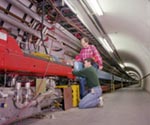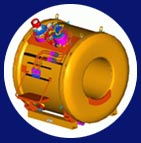

 dvances in technology for medical diagnosis have created extraordinary new capabilities for imaging the human body. Many of medicine's most powerful diagnostic tools incorporate
technology that physicists originally developed to explore the fundamental nature of matter.
dvances in technology for medical diagnosis have created extraordinary new capabilities for imaging the human body. Many of medicine's most powerful diagnostic tools incorporate
technology that physicists originally developed to explore the fundamental nature of matter.
Magnetic resonance imaging uses technology that began as a tool for physicists to accelerate protons to the highest energy in the world.
MRI is a technique used to produce high quality images of the inside of the human body. MRI is based on the principles of nuclear magnetic resonance, a technique used by scientists to obtain microscopic chemical and physical information about molecules.
 At the heart of MRI technology are powerful magnets made of superconducting wire and cable first developed in the 1970s to build Fermilab's Tevatron.
At the heart of MRI technology are powerful magnets made of superconducting wire and cable first developed in the 1970s to build Fermilab's Tevatron.
 To build the Tevatron, Fermilab brought together experts in superconductivity, physics, engineering, material science and manufacturing. Their collaboration made superconducting magnet technology ready for a full-grown role in the new diagnostic capability created by MRI.
To build the Tevatron, Fermilab brought together experts in superconductivity, physics, engineering, material science and manufacturing. Their collaboration made superconducting magnet technology ready for a full-grown role in the new diagnostic capability created by MRI.
A new generation of superconducting magnets will give physicists more powerful accelerators to unlock the deepest secrets of the universe. And a new generation of high-field superconducting MRI magnets will help unlock the secrets of the human body.
|